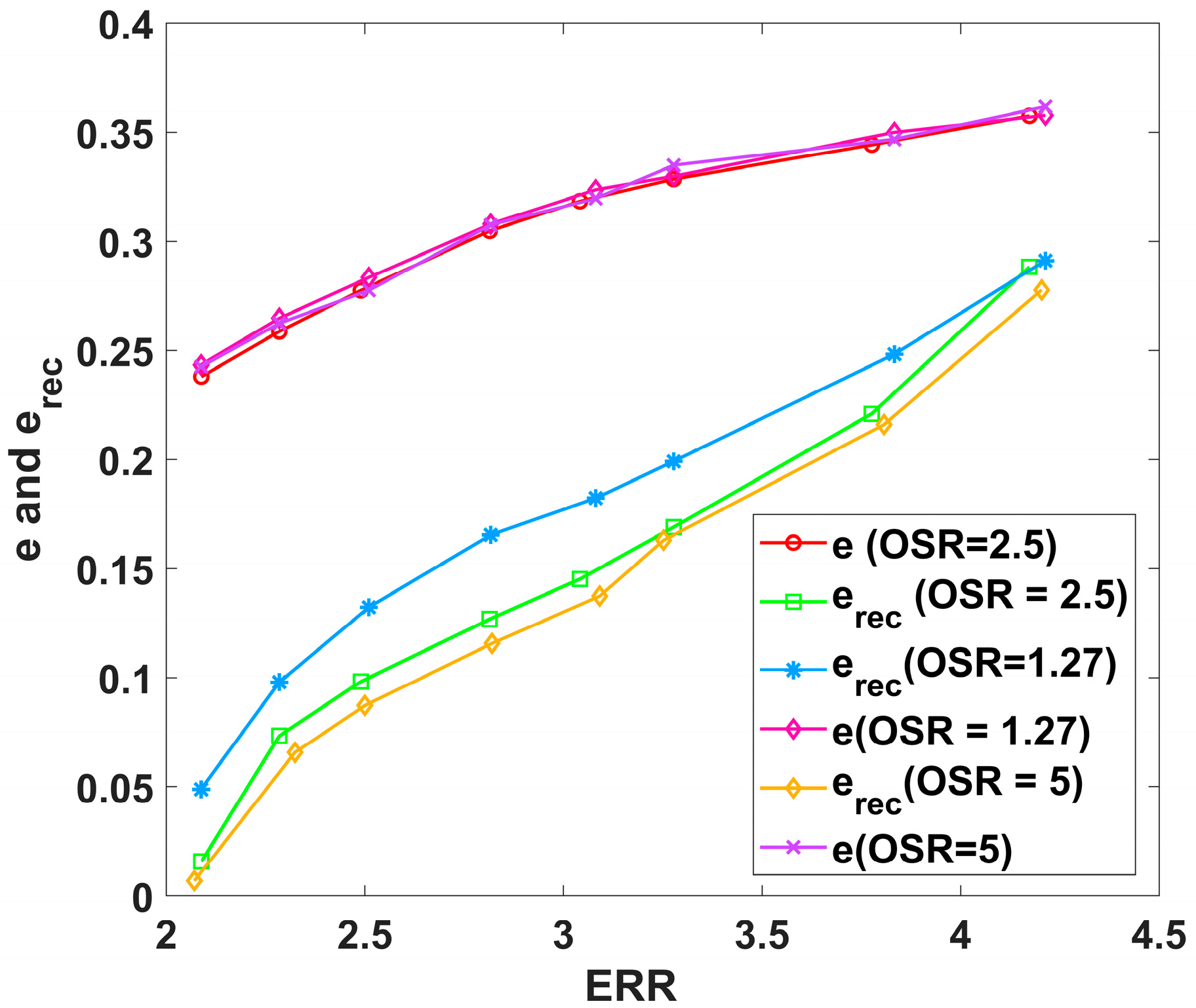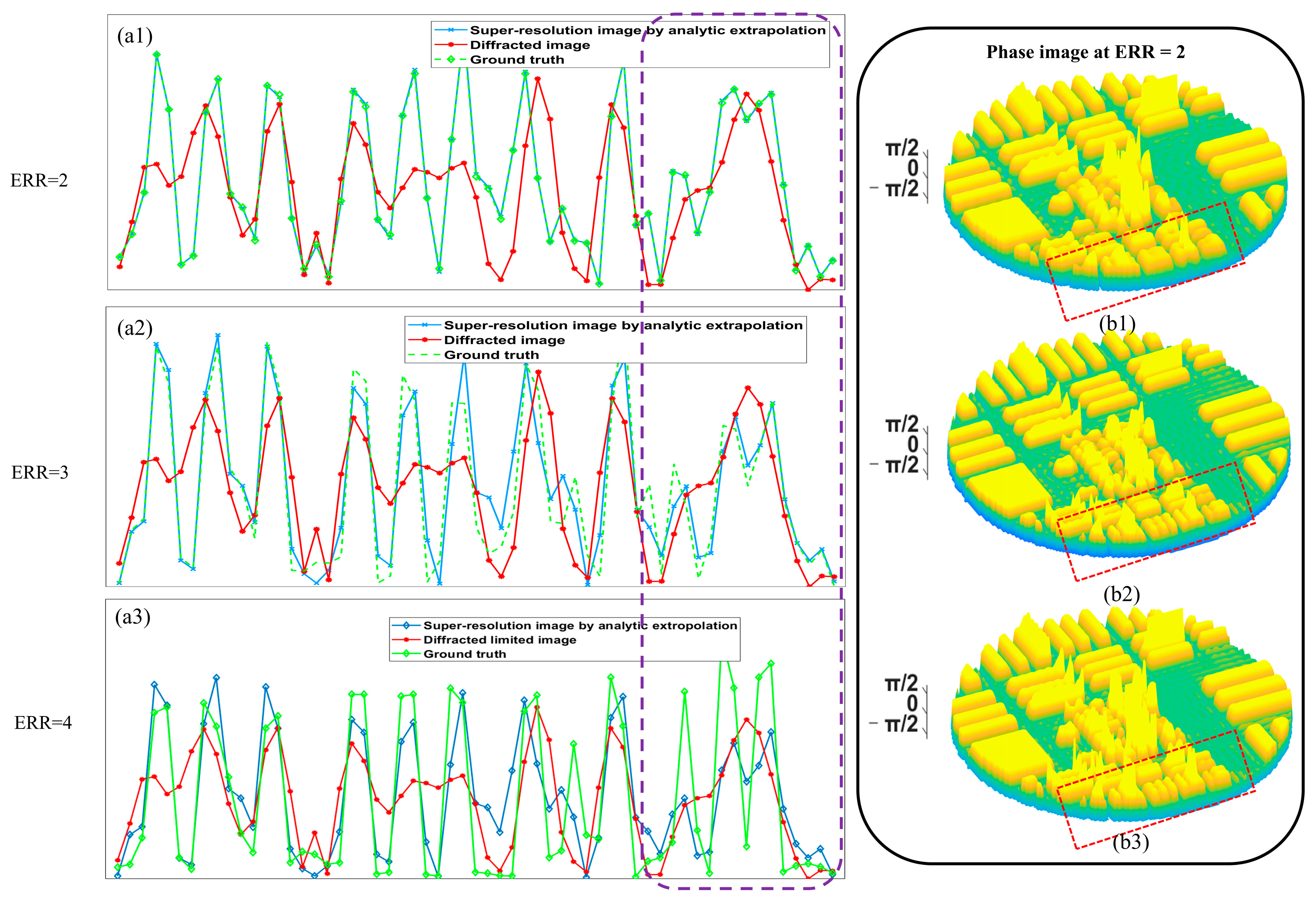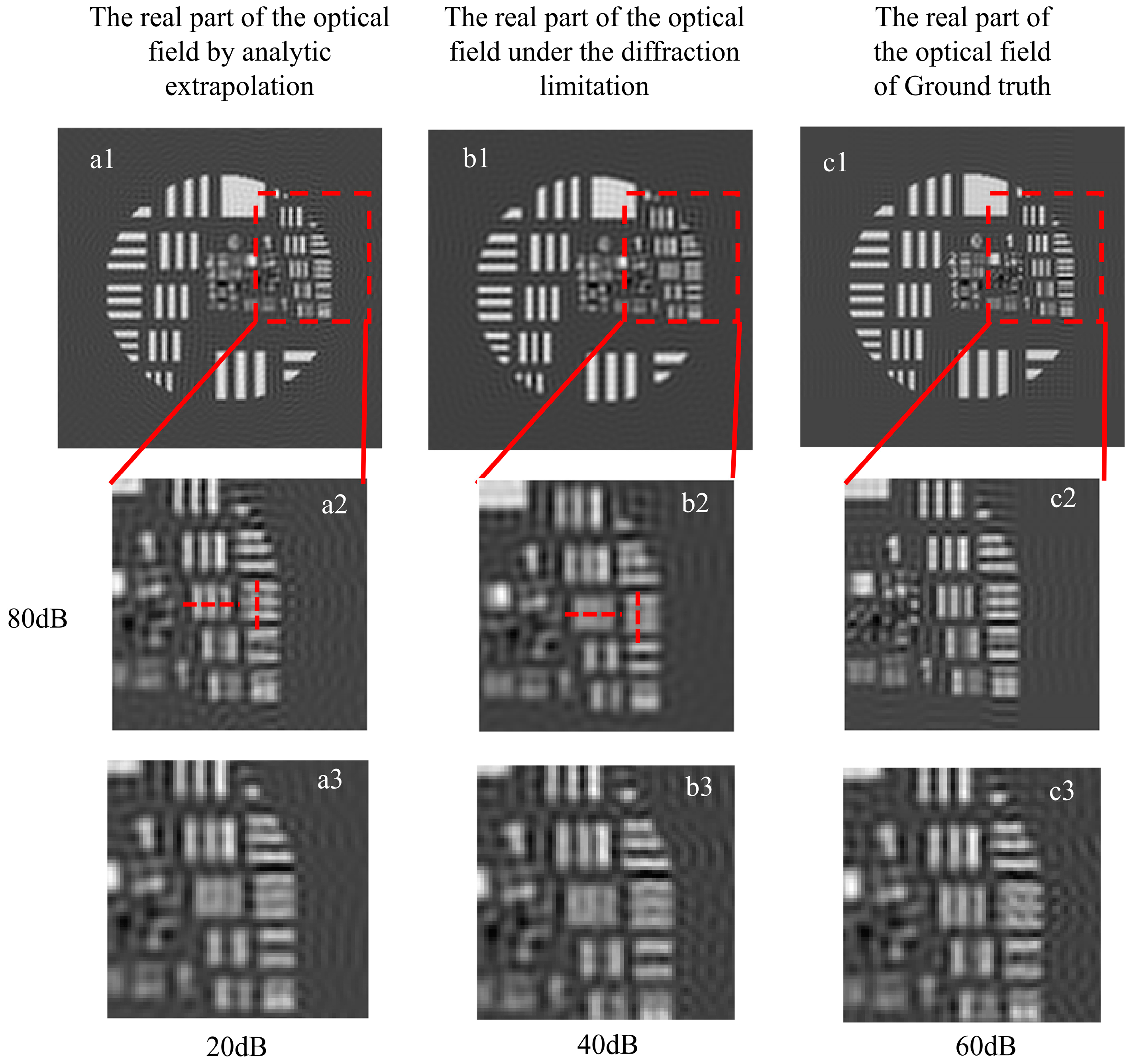Single-Shot Super-Resolution Phase Imaging Method Using Band-Limited Image and Its Fourier Transform Constraints via Analytic Extrapolation
Abstract
:1. Introduction
2. Method
2.1. The Princleple of BIFT Phase Imaging System
2.2. The Super-Resolution BIFT Imaging by Analytic Extrapolation
- 1
- The optical field exhibits continuous differentiability and can be extended indefinitely in the Fourier plane;
- 2
- Any point of the optical field can be expressed as the sum of each other points in the field. In other words, any point of the optical field is not independent from others;
- 3
- The entire function can be uniquely determined by its behavior within any arbitrarily small region. The unknown portion of the analytic function can be inferred from its analyticity in that small region.
3. Simulation Result
3.1. The Performance of the Analytic Extrapolation in the Noise-Free Condition
3.2. Improving the Recovery from Noise by Analytic Extrapolation
4. Conclusions
Author Contributions
Funding
Institutional Review Board Statement
Informed Consent Statement
Data Availability Statement
Conflicts of Interest
References
- Millane, R.P. Phase retrieval in crystallography and optics. J. Opt. Soc. Am. A 1990, 7, 394–411. [Google Scholar] [CrossRef]
- Dainty, J.C.; Fienup, J.R. Phase retrieval and image reconstruction for astronomy. In Image Recovery Theory & Application; Academic Press: Cambridge, MA, USA, 1987. [Google Scholar]
- Nam, D.; Park, J.; Gallagher-Jones, M.; Kim, S.; Kim, S.; Kohmura, Y.; Naitow, H.; Kunishima, N.; Yoshida, T.; Ishikawa, T.; et al. Imaging Fully Hydrated Whole Cells by Coherent X-Ray Diffraction Microscopy. Phys. Rev. Lett. 2013, 110, 098103. [Google Scholar] [CrossRef]
- Park, Y.; Depeursinge, C.; Popescu, G. Quantitative phase imaging in biomedicine. Nat. Photonics 2018, 12, 578–589. [Google Scholar] [CrossRef]
- Tahara, T.; Quan, X.; Otani, R.; Takaki, Y.; Matoba, O. Digital holography and its multidimensional imaging applications: A review. Microscopy 2018, 67, 55–67. [Google Scholar] [CrossRef]
- Shechtman, Y.; Eldar, Y.C.; Cohen, O.; Chapman, H.N.; Miao, J.; Segev, M. Phase Retrieval with Application to Optical Imaging: A contemporary overview. IEEE Signal Process. Mag. 2015, 32, 87–109. [Google Scholar] [CrossRef]
- Zernike, F. Phase contrast, a new method for the microscopic observation of transparent objects part II. Physica 1942, 9, 974–986. [Google Scholar] [CrossRef]
- Gabor, D. A New Microscopic Principle. Nature 1948, 161, 777–778. [Google Scholar] [CrossRef]
- Miao, J.; Sayre, D.; Chapman, H.N. Phase retrieval from the magnitude of the Fourier transforms of nonperiodic objects. J. Opt. Soc. Am. A 1998, 15, 1662–1669. [Google Scholar] [CrossRef]
- Fienup, J.R. Reconstruction of a complex-valued object from the modulus of its Fourier transform using a support constraint. J. Opt. Soc. Am. A 1987, 4, 118–123. [Google Scholar] [CrossRef]
- Koren, G.; Polack, F.; Joyeux, D. Iterative algorithms for twin-image elimination in in-line holography using finite-support constraints. J. Opt. Soc. Am. A 1993, 10, 423–433. [Google Scholar] [CrossRef]
- Shechtman, Y.; Beck, A.; Eldar, Y.C. GESPAR: Efficient Phase Retrieval of Sparse Signals. IEEE Trans. Signal Process. 2014, 62, 928–938. [Google Scholar] [CrossRef]
- Denis, L.; Lorenz, D.; Thiébaut, E.; Fournier, C.; Trede, D. Inline hologram reconstruction with sparsity constraints. Opt. Lett. 2009, 34, 3475–3477. [Google Scholar] [CrossRef] [PubMed]
- Zhang, W.; Cao, L.; Brady, D.J.; Zhang, H.; Cang, J.; Zhang, H.; Jin, G. Twin-Image-Free Holography: A Compressive Sensing Approach. Phys. Rev. Lett. 2018, 121, 093902. [Google Scholar] [CrossRef] [PubMed]
- Beinert, R. Non-negativity constraints in the one-dimensional discrete-time phase retrieval problem. Inf. Inference J. IMA 2017, 6, 213–224. [Google Scholar] [CrossRef]
- Beinert, R.; Plonka, G. Ambiguities in One-Dimensional Discrete Phase Retrieval from Fourier Magnitudes. J. Fourier Anal. Appl. 2015, 21, 1169–1198. [Google Scholar] [CrossRef]
- Yamaguchi, I.; Ida, T.; Yokota, M.; Yamashita, K. Surface shape measurement by phase-shifting digital holography with a wavelength shift. Appl. Opt. 2006, 45, 7610–7616. [Google Scholar] [CrossRef]
- Yamaguchi, I. Phase-Shifting Digital Holography. In Digital Holography and Three-Dimensional Display: Principles and Applications; Poon, T.-C., Ed.; Springer: Boston, MA, USA, 2006; pp. 145–171. [Google Scholar] [CrossRef]
- Yamaguchi, I.; Kato, J.-i.; Ohta, S. Surface Shape Measurement by Phase-Shifting Digital Holography. Opt. Rev. 2001, 8, 85–89. [Google Scholar] [CrossRef]
- Nakatsuji, T.; Matsushima, K. Free-viewpoint images captured using phase-shifting synthetic aperture digital holography. Appl. Opt. 2008, 47, D136–D143. [Google Scholar] [CrossRef]
- Popescu, G.; Deflores, L.P.; Vaughan, J.C.; Badizadegan, K.; Iwai, H.; Dasari, R.R.; Feld, M.S. Fourier phase microscopy for investigation of biological structures and dynamics. Opt. Lett. 2004, 29, 2503–2505. [Google Scholar] [CrossRef] [PubMed]
- Pedrini, G.; Osten, W.; Zhang, Y. Wave-front reconstruction from a sequence of interferograms recorded at different planes. Opt. Lett. 2005, 30, 833–835. [Google Scholar] [CrossRef]
- Rodenburg, J.M. Ptychography and Related Diffractive Imaging Methods. In Advances in Imaging and Electron Physics; Hawkes, Ed.; Elsevier: Amsterdam, The Netherlands, 2008; Volume 150, pp. 87–184. [Google Scholar]
- Zheng, G.; Horstmeyer, R.; Yang, C. Wide-field, high-resolution Fourier ptychographic microscopy. Nat. Photonics 2013, 7, 739–745. [Google Scholar] [CrossRef] [PubMed]
- Kong, X.; Xiao, K.; Wang, K.; Li, W.; Sun, J.; Wang, Z. Phase microscopy using band-limited image and its Fourier transform constraints. Opt. Lett. 2023, 48, 3251–3254. [Google Scholar] [CrossRef] [PubMed]
- Xiao, K.; Kong, X.; Wang, Z. Unique phase retrieval with a bandlimited image and its Fourier transformed constraints. J. Opt. Soc. Am. A 2023, 40, 2223–2239. [Google Scholar] [CrossRef]
- Neifeld, M.A. Information, resolution, and space–bandwidth product. Opt. Lett. 1998, 23, 1477–1479. [Google Scholar] [CrossRef]
- Peng, G.; Caojin, Y. Resolution enhancement of digital holographic microscopy via synthetic aperture: A review. Light Adv. Manuf. 2022, 3, 105–120. [Google Scholar] [CrossRef]
- Granero, L.; Micó, V.; Zalevsky, Z.; García, J. Superresolution imaging method using phase-shifting digital lensless Fourier holography. Opt. Express 2009, 17, 15008–15022. [Google Scholar] [CrossRef]
- Micó, V.; Ferreira, C.; García, J. Surpassing digital holography limits by lensless object scanning holography. Opt. Express 2012, 20, 9382–9395. [Google Scholar] [CrossRef]
- Li, D.; Shao, L.; Chen, B.-C.; Zhang, X.; Zhang, M.; Moses, B.; Milkie, D.E.; Beach, J.R.; Hammer, J.A.; Pasham, M.; et al. Extended-resolution structured illumination imaging of endocytic and cytoskeletal dynamics. Science 2015, 349, aab3500. [Google Scholar] [CrossRef]
- Chowdhury, S.; Eldridge, W.J.; Wax, A.; Izatt, J.A. Structured illumination multimodal 3D-resolved quantitative phase and fluorescence sub-diffraction microscopy. Biomed. Opt. Express 2017, 8, 2496–2518. [Google Scholar] [CrossRef] [PubMed]
- Bian, L.; Suo, J.; Situ, G.; Zheng, G.; Chen, F.; Dai, Q. Content adaptive illumination for Fourier ptychography. Opt. Lett. 2014, 39, 6648–6651. [Google Scholar] [CrossRef]
- Dong, S.; Shiradkar, R.; Nanda, P.; Zheng, G. Spectral multiplexing and coherent-state decomposition in Fourier ptychographic imaging. Biomed. Opt. Express 2014, 5, 1757–1767. [Google Scholar] [CrossRef] [PubMed]
- Tian, L.; Li, X.; Ramchandran, K.; Waller, L. Multiplexed coded illumination for Fourier Ptychography with an LED array microscope. Biomed. Opt. Express 2014, 5, 2376–2389. [Google Scholar] [CrossRef] [PubMed]
- He, X.; Liu, C.; Zhu, J. Single-shot Fourier ptychography based on diffractive beam splitting. Opt. Lett. 2018, 43, 214–217. [Google Scholar] [CrossRef] [PubMed]
- Lee, B.; Hong, J.-y.; Yoo, D.; Cho, J.; Jeong, Y.; Moon, S.; Lee, B. Single-shot phase retrieval via Fourier ptychographic microscopy. Optica 2018, 5, 976–983. [Google Scholar] [CrossRef]
- Sun, J.; Chen, Q.; Zhang, J.; Fan, Y.; Zuo, C. Single-shot quantitative phase microscopy based on color-multiplexed Fourier ptychography. Opt. Lett. 2018, 43, 3365–3368. [Google Scholar] [CrossRef]
- Romberg, J. Imaging via Compressive Sampling. IEEE Signal Process. Mag. 2008, 25, 14–20. [Google Scholar] [CrossRef]
- Candes, E.J.; Romberg, J.; Tao, T. Robust uncertainty principles: Exact signal reconstruction from highly incomplete frequency information. IEEE Trans. Inf. Theory 2006, 52, 489–509. [Google Scholar] [CrossRef]
- Brady, D.J.; Choi, K.; Marks, D.L.; Horisaki, R.; Lim, S. Compressive Holography. Opt. Express 2009, 17, 13040–13049. [Google Scholar] [CrossRef]
- Marchesini, S.; He, H.; Chapman, H.N.; Hau-Riege, S.P.; Noy, A.; Howells, M.R.; Weierstall, U.; Spence, J.C.H. X-ray image reconstruction from a diffraction pattern alone. Phys. Rev. B 2003, 68, 140101. [Google Scholar] [CrossRef]
- Harris, J.L. Diffraction and Resolving Power. J. Opt. Soc. Am. 1964, 54, 931–936. [Google Scholar] [CrossRef]
- Fienup, J.R. Reconstruction and Synthesis Applications of an Iterative Algorithm. Transform. Opt. Signal Process. 1984, 373, 147–160. [Google Scholar]








Disclaimer/Publisher’s Note: The statements, opinions and data contained in all publications are solely those of the individual author(s) and contributor(s) and not of MDPI and/or the editor(s). MDPI and/or the editor(s) disclaim responsibility for any injury to people or property resulting from any ideas, methods, instructions or products referred to in the content. |
© 2024 by the authors. Licensee MDPI, Basel, Switzerland. This article is an open access article distributed under the terms and conditions of the Creative Commons Attribution (CC BY) license (https://creativecommons.org/licenses/by/4.0/).
Share and Cite
Xiao, K.; Wang, Z. Single-Shot Super-Resolution Phase Imaging Method Using Band-Limited Image and Its Fourier Transform Constraints via Analytic Extrapolation. Appl. Sci. 2024, 14, 8466. https://doi.org/10.3390/app14188466
Xiao K, Wang Z. Single-Shot Super-Resolution Phase Imaging Method Using Band-Limited Image and Its Fourier Transform Constraints via Analytic Extrapolation. Applied Sciences. 2024; 14(18):8466. https://doi.org/10.3390/app14188466
Chicago/Turabian StyleXiao, Kang, and Zhongyang Wang. 2024. "Single-Shot Super-Resolution Phase Imaging Method Using Band-Limited Image and Its Fourier Transform Constraints via Analytic Extrapolation" Applied Sciences 14, no. 18: 8466. https://doi.org/10.3390/app14188466



